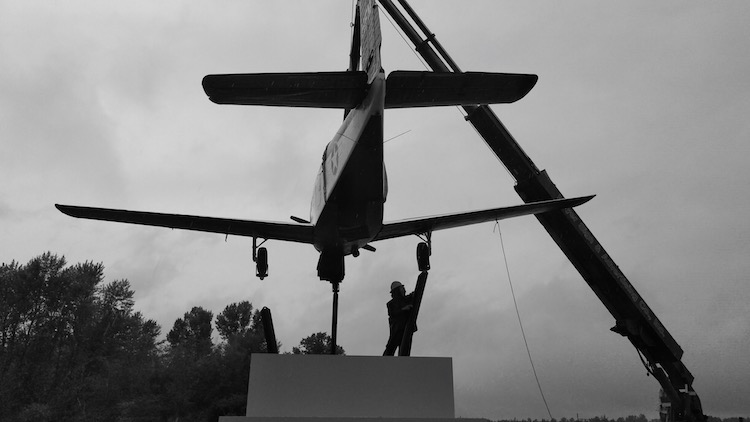Tales From the Magic Skagit: Into the Wild Blue Yonder
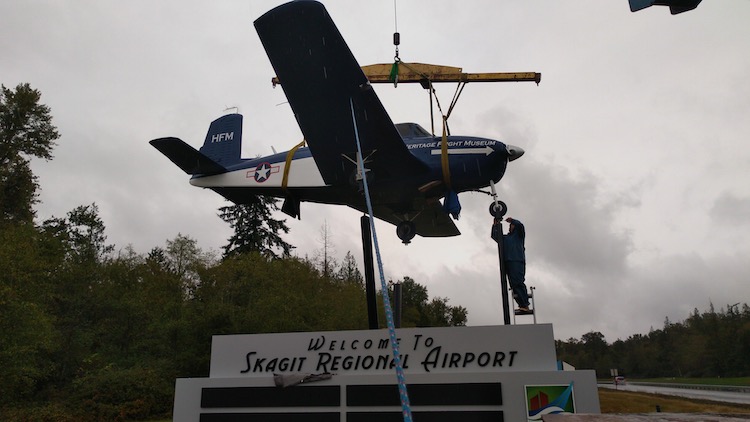
If you’ve been following our Meyer Sign stories for any length of time, you’ve no doubt noticed by now that of the many things we talk about, signs are not typically our topic of choice.
Trust me, it isn’t because we don’t find the subject of “signage” to be endlessly fascinating. Because we are essentially a full-custom manufacturer, virtually all of our projects are one-off creations that are as unique as the people for whom we design, fabricate, and build them. That said, however, getting into the weeds on sign creation is a bit too much “inside baseball” — even for us!
That said, every now and again a sign project comes along that elevates the story of its evolution to “must read” status — not simply because of how the sign was made and installed, but because of how it came into being in the first place. Such is the case with our recent signage project on behalf of the Port of Skagit and Heritage Flight Museum — images and video of which we shared during the sign’s installation over a couple of wet and wild days at the end of September.
This is the story of that sign, and why we think it deserves to be included in our “Tales From the Magic Skagit” series.
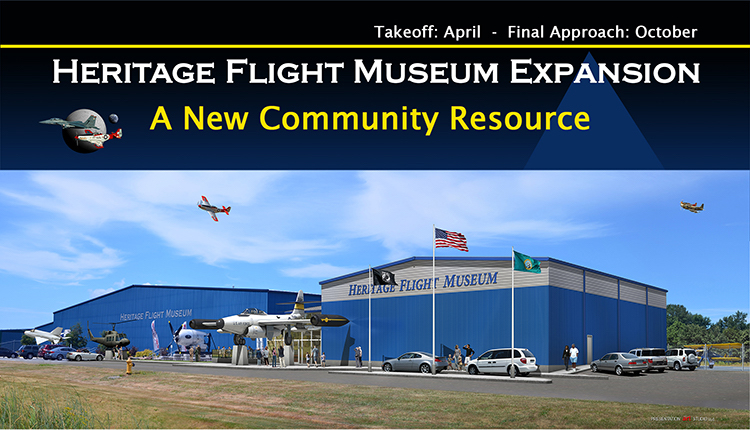
The Heritage Flight Museum’s Skagit Valley history began just seven years ago, when its founders (Apollo 8 astronaut William Anders, wife Valerie, and two of their sons) moved the museum from Bellingham to Burlington. The story of its relocation tells you as much about the vision and energy of the Port of Skagit and its commissioners as it does about the vision of the museum.
Due to post-9/11 strictures emanating from the Department of Homeland Security, Bellingham’s ambitions to host a commercial services airport did not mesh well with Heritage Flight Museum’s plans for its future and its contemplated expansion. As Port of Skagit executive director Sara Young explains, “There was a fundamental misalignment in policy direction that manifested itself in availability of land and leasing costs — and the Port of Skagit’s focus on general aviation services made it much more compatible with how the Anders family wanted to evolve their museum.”
Sara describes the initial relationship between the Port and Heritage, which began prior to her becoming executive director, as “a courtship period of mutual vetting and getting a sense of what would be the win-win for both parties at a time when the museum was looking for a new home.” Among the factors that ultimately consummated the relationship was the fact that one of the Port’s commissioners, Kevin Ware, was himself a pilot, and both Sara and Heritage Flight Museum’s executive director, Lt. Col. Greg Anders, have cited his enthusiasm and support for the museum’s vision in convincing the Anders family to make Skagit County its address.
In addition to the Port of Skagit’s embrace of the museum, there was also the fact that a building was available that would suit its expansion plans. Local contractor and aviator Dean Holt, who had previously constructed some of the hangers at Skagit Regional Airport, had created what is known in the aviation industry as a “fixed base operator” (FBO) — a facility for aviation needs such as fuel services, aircraft marshaling and storage, pilot services, mechanic and avionic services, etc. that provides a one-stop shop for maintaining and managing aircraft. Holt sold the FBO facility to the Anders family, who readily adapted it to become a showcase for their vintage aircraft as well as provide administrative and exhibit space.
Looking back on the history of Heritage Flight Museum since it adopted the Port of Skagit as its new home, Sara Young feels that the potential both parties originally sensed in their relationship has been more than fulfilled. “They have brought a lot of life and light to our airport,” Sara notes, “and the Port commission is very supportive of them. They are pretty special. When you walk through their door you get the sense that they are serving as a repository of military history that is localized for the people in this area — and then there is this huge cultural and historical significance connected with the Apollo 8 mission.”
In promoting Heritage Flight Museum as a destination venue that would in turn generate greater public awareness of the Port of Skagit’s mission as an economic and cultural hub, Sara and the Port commissioners realized that signage would play an important role.
As Sara recalls, “The discussion over the Heritage sign began a couple of years ago as a way to recognize its uniqueness and its connection with the airport and the Port of Skagit. The plan was iterative, starting with the recognition that Heritage needed more visibility. Historically, the Port has had manufacturing businesses that don’t necessarily need more commercial presence or curb visibility, but that has changed over the years. Now we have breweries (Chuckanut Brewery, Garden Path Fermentation, and Cardinal Craft Brewing Academy), a restaurant (Skagit Landing), King Arthur Baking Company — businesses that would like more traffic and presence, not to mention simply reminding people that we do have an airport here as well. We wanted to tell their story and have a more exciting entry for the airport, all of which we thought we could accomplish with the right sign.”
“The right sign” is a perfect segue to Meyer Sign’s role in this project…and that of the late (great) Gregg Collins. Meyer Sign owner, Ken Hitt, takes over the narrative from here.
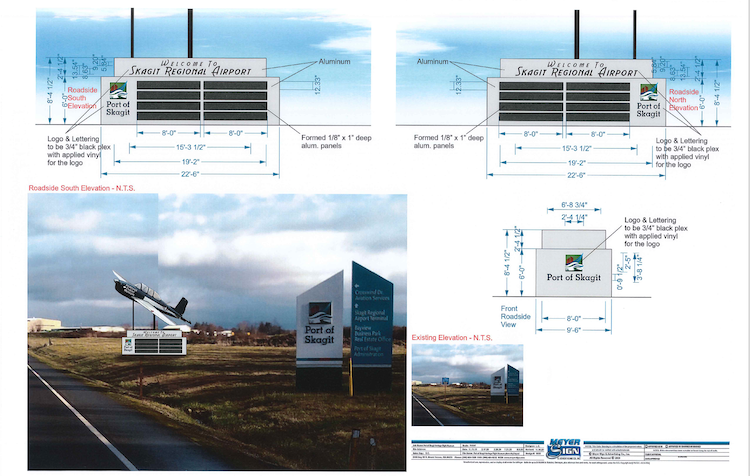
“Gregg was the instigator,” Ken remembers, “he was dealing with this project from the very beginning. I remember going to a meeting with him and the Port of Skagit and Heritage Flight Museum about a year ago, and they were talking about doing the sign. Gregg got to work on all the design phases of it, and getting it all set up. This project was really close to his heart.”
It was during that first meeting, which involved Sara Young in her then capacity as the Port’s director of planning and facilities, that the initial concept for the sign was discussed, including the incorporation of a museum plane (a retired T-34 trainer) as part of the structure. “What I remember about the expectations for the sign was that Port of Skagit wanted to drive more awareness for the museum, and in doing so get the overall advertising benefit for the Port that went along with it,” Ken Hitt recalls. Needless to say, this project came with some big ambitions written into the specs.
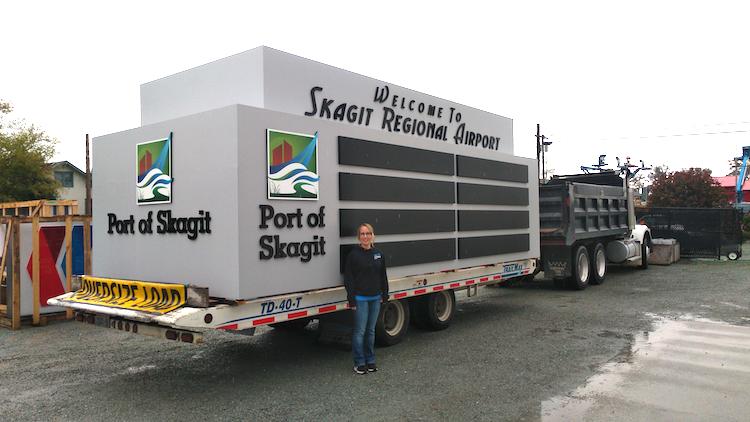
From here the Meyer Sign fabrication team took over. “We had three fabricators working on this project,” says Ken. “Its basic design was two large boxes with the largest one on the bottom, assembled and fabricated in one piece in the shop from 2×2 steel box tubing cut and welded together, then covered with 1/8-inch aluminum sheeting. The structure weighs about 1,500-2,000 pounds. It is really big when you stand next to it — which you can see in a photo we took of our office manager, Kristi Hilsinger, standing next to the trailer we loaded it on prior to transporting it to the job site at Port of Skagit.”
The museum had a sketch of the design concept they had in mind — to which Meyer Sign added what the Port was looking for — and this was turned over to Meyer Sign designer Lisa Corp, who came up with the final creative execution. Following its blessing by the Port and the museum, Meyer Sign then handed off the design to engineering partner Gary Sturdy (Sturdy Engineering). “Gary basically engineered the foundation and steel structures that would hold the plane, and made sure that the sign was designed to handle wind loads and other environmental stress to which it might be subjected.”

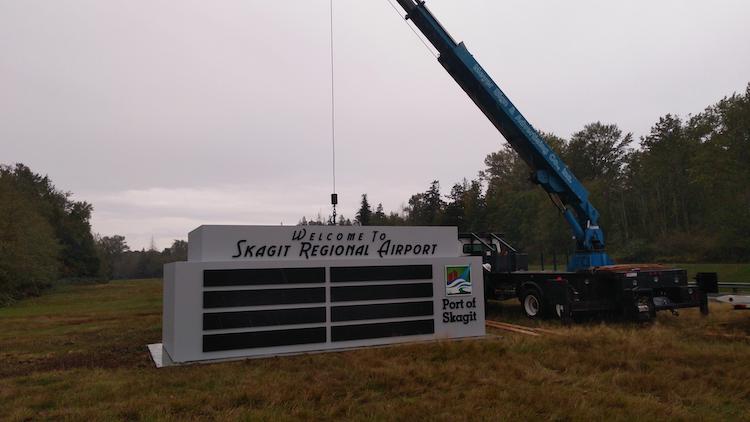
To secure a monument sign of this size, Meyer Sign first dug a foundation that was 12×22 feet and two feet deep, with rebar mesh on the bottom and on the top. The installation crew poured an additional concrete slab on top of the foundation so that the base of the sign would sit above grade — two pours with anchor bolts in the first pour for pre-assembly.
Then came the tricky part. “Our lead fabricator went to the site where the plane was and took all the dimensions and spacing associated with the landing gear, which would form the attachment points to the upper pedestal of the sign. Then he came back and fabricated all the mounts and welded them to the plane. Once we stood the pipes up on the anchor bolts on the top box and lowered the plane onto it, it fit like a glove. I still don’t know how he accomplished that!”
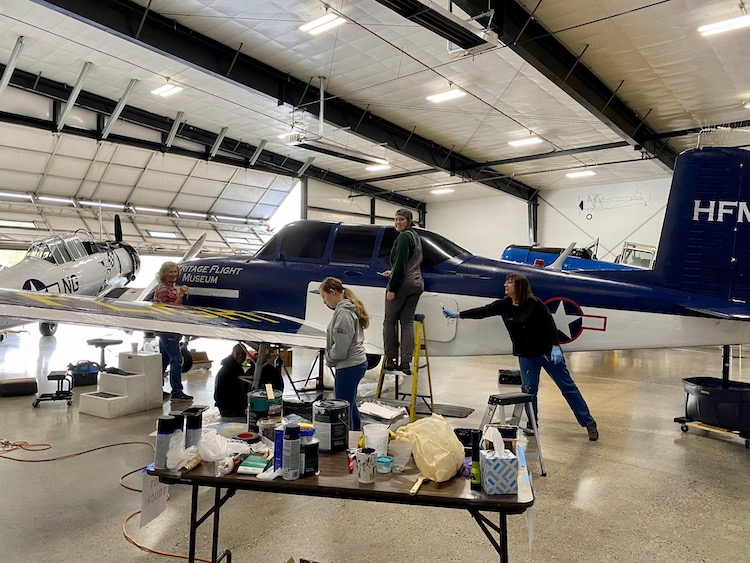
From Ken’s point of view, the biggest challenge with the project was not the design, engineering, or fabrication — which, ambitious as it was, was squarely in Meyer Sign’s wheelhouse. It was getting the project finished by a drop dead date that coincided with the original plans for dedicating the museum’s new hangar building (which was ultimately postponed due to construction delays). “We had a firm due date with the Port of October 5, but I wanted to complete the project a week ahead of schedule.”
On a wet and blustery October 1, Meyer Sign delivered on its commitment. Using a reach forklift (thank you, Chad Fisher Construction) the plane was moved down the road, which the Port had temporarily blocked, and set down on the grass beside the sign. Meyer Sign’s installation crew took over from here, and the work progressed speedily despite the inclement weather.
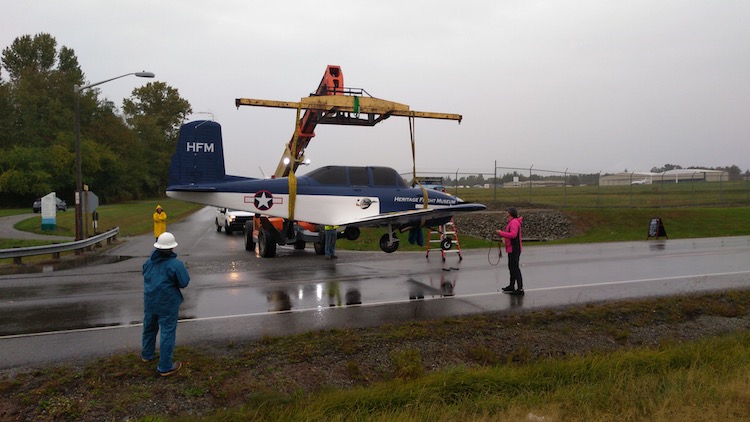

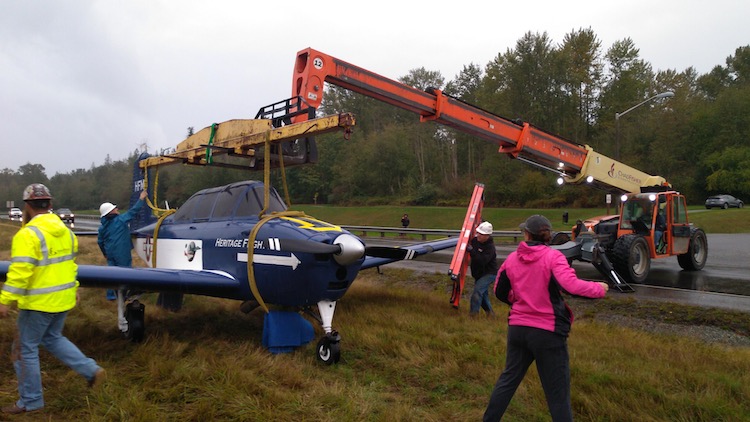

As Ken recalls, “Our crew got to the job site at 9:30 that morning, after having prepared it the day before — during which the weather was also nasty. We got the plane rigged up and lifting the way we wanted it for control, then swung it into place and attached it. Our crew was back by 3:00 that afternoon. If we had tried to accomplish everything in one day rather than two, it would have been a really long day in really bad conditions. As it was, we were battling the weather because of the impact it was having on the site. The ground, which is as hard as a rock in the summer, had turned into clay. We couldn’t have made many more trips in and out of the site before it would have been impassable. Once that clay comes up through the grass, you’re done.”
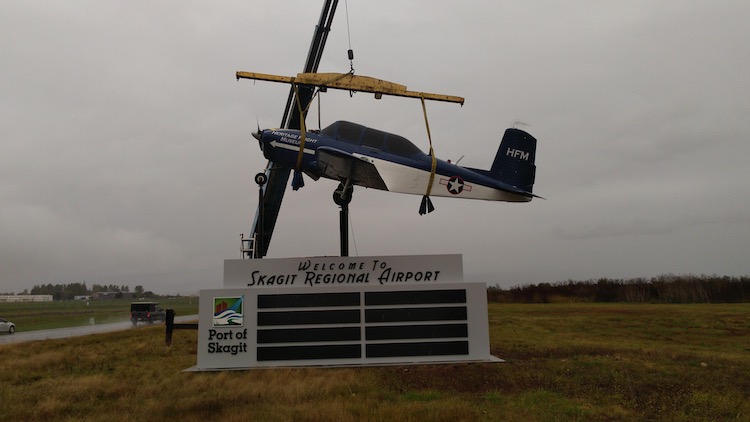
Overall, the execution and logistics around the creation of the Port of Skagit’s new monument sign make it among the most significant projects Meyer Sign has undertaken. It is certainly one of the most significant for Ken, and some bragging rights are in order. “There are a few sign companies around that might have pulled this project off, but I don’t know many that would have taken it on to begin with because of the amount of steel fabrication and engineering that was involved. But it was right in our sweet spot in terms of skill set.”
To Ken’s point regarding “skill sets,” there are plenty of kudos to go around: Lisa Corp’s design talents, the expertise of our fabrication team, the competence, speed, and precision of our installation crew, the assistance we received from Heritage Flight Museum (especially from head mechanic, Cassidy), and last but not least, the Port of Skagit — not only with regard to the sign’s role in promoting Heritage Flight Museum as a destination venue, but for its long-term vision for the Port’s role in the life of our Magic Skagit.
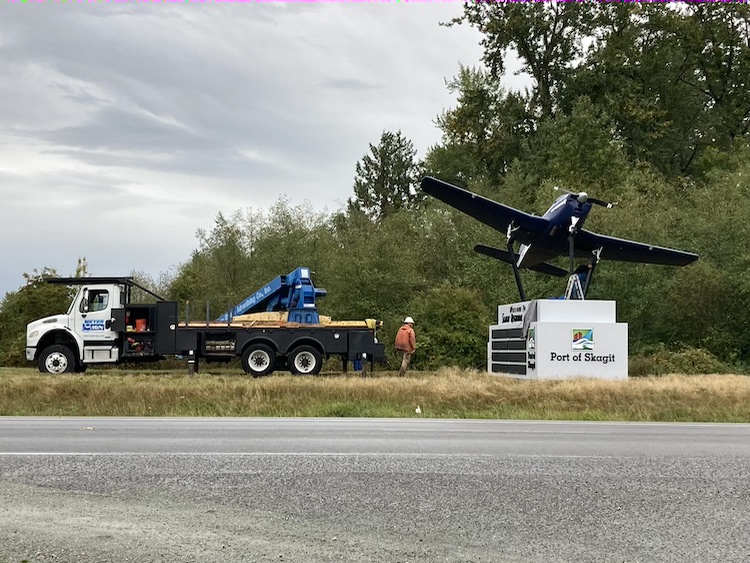
As Port of Skagit’s executive director, Sara Young, explains, the new sign is the continuation of a broader marketing strategy reflecting the Port’s identity and evolution. “This sign is the beginning of creating some excitement around what is already happening here at the Port — something broader than just Heritage, which is an anchor for the whole thing. Obviously, they create excitement, but this sign also has benefits other businesses that can create some synergy and mutual energy — a hub for which the museum represents a cultural connection. We are creating destinations, not just buildings, and this sign is a work in progress that supports a larger branding effort.”
For Meyer Sign, the Heritage Flight Museum/Port of Skagit monument sign is deeply personal — not just because we are proud of the statement it makes about our ca[abilities as a sign company and our connection with the Skagit Valley, but even more so because of its significance to Gregg Collins. Ken puts it succinctly. “Gregg fought really hard for this job because it was more than a sign for him — it was something unlike anything we had done before, and he was so happy and excited when we got the job.”
Gregg passed away less than a month before the sign’s installation, but we know how proud he would have been to have seen it come to fulfillment. None of us at Meyer Sign will ever drive past it without thinking of our friend and his love and devotion to not only the people he worked with, but to the community he worked for. We can’t think of a more “soaring” testament to the memory of one who “slipped the surly bonds of earth…to touch the face of God,” to quote a 19-year old RAF pilot, John Gillespie Magee in his poem, “High Flight.”
We’ll see you when we get there, buddy.
